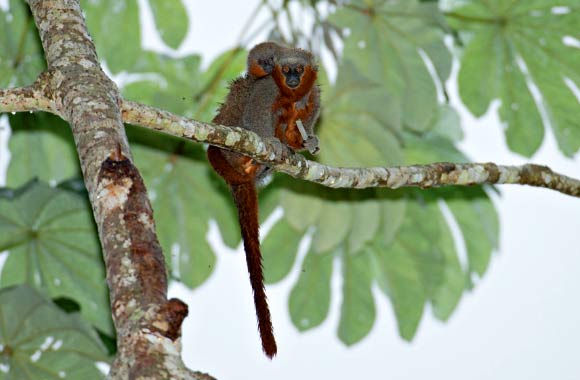A team of scientists led by Dr Julio César Dalponte of the Institute for the Conservation of Neotropical Carnivores in Atibaia has described a new species of titi monkey (genus Callicebus) from Brazil.

Family group of Milton’s titi monkeys (Callicebus miltoni) in the undercanopy of the ombrophilous forest at Panelas, right bank of the Roosevelt River, northwestern Mato Grosso, Brazil. Image credit: A. Gambarini.
Titi monkeys, or the titis, represent one of the most diverse Neotropical primate groups, with 32 species currently recognized.
These tree-dwelling monkeys are small – between 9 and 18 inches (23-46 cm) tall, but are striking due to their coloration.
They are primarily fruit eaters, have long, soft fur and live in small family groups consisting of a monogamous pair and their offspring.
These monkeys prefer dense forests near water and easily jump from branch to branch, earning them their German name, jumping monkey. They sleep at night, but also take a midday nap.
In 2011, Dr Dalponte and his colleagues from the Institute for the Sustainable Development of Mamirauá (ISDM) and the Emilio Goeldi Museum spotted an unusual looking titi monkey on the east bank of the Roosevelt River, whose coloration did not match any known species.

The Milton’s titi monkey (Callicebus miltoni), compared to geographically neighboring species – the Prince Bernhard’s Titi Monkey (Callicebus bernhardi) and the ashy black titi (Callicebus cinerascens). Image credit: Stephen D. Nash.
Intrigued, they headed back into the field to collect the information needed to formally describe what they believed to be a new species.
Over the course of a number of expeditions, they recorded several groups of these unusual monkeys, whose ochre sideburns, bright orange tail and light grey forehead stripe set them apart from other known species in the genus.
Based on these morphological differences, they were able to describe the monkey as a new species, the Milton’s titi monkey (Callicebus miltoni).
The species name honors Brazilian primatologist Dr Milton Thiago de Mello, in recognition of his contribution to development of primatology.
“It goes without saying that we are really excited about this new discovery,” said Dr Felipe Ennes Silva of the ISDM, who is a co-author of the paper published in the journal Papéis Avulsos de Zoologia.

Adult Milton’s titi monkey (Callicebus miltoni) eating a fruit while carrying a baby at Roosevelt River, Mato Grosso, Brazil. Image credit: A. Gambarini.
“It is always thrilling to find something new in the Amazon, as it reminds us just how special this rainforest is and how lucky we are to have it on our doorstep.”
Milton’s titi monkeys are found in the Brazilian states of Mato Grosso, Amazonas and Rondônia.
Like their close relatives, they live in small groups consisting of a mated pair and their offspring. These groups are territorial and use warning calls to keep others at bay – they are particularly vociferous early in the morning and during the rainy season.
Because they are not able to swim or cross mountainous terrain, Milton’s titi monkeys are restricted to a small area, effectively hemmed in by a number of rivers and hills.
_____
Julio César Dalponte et al. 2014. New species of titi monkey, genus Callicebus Thomas, 1903 (Primates, Pitheciidae), from Southern Amazonia, Brazil. Pap. Avulsos Zool., vol. 54, no. 32, pp. 457-472; doi: 10.1590/0031-1049.2014.54.32







